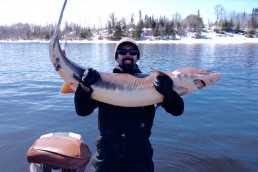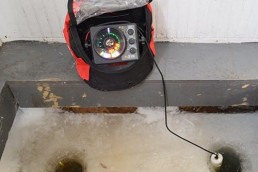Inky Nights, Flying Pop Cans, and Monster Flatheads
SHARE THIS POST
It was dark. I mean real dark. I was fishing Seneca Lake a number of years ago with flathead catfish legend, Roy Hoops, and a couple of his friends. It was pitch black, because there were no glowing lanterns or light of any kind. Roy felt that light scared away the big cats. I’ve never heard that before, but I learned long ago that you don’t argue with a legend.
A flying pop can clattered in the inky darkness.
“Fish on!” Hoops yelled.
Everyone jumped to their feet to check their fishing rods. I will explain the significance of the pop can later.
Denny shouted, “I got one on!”
Boy did he ever. His rod bent over in a painful C as the monster stretched the 40-pound-test fishing line singing tight. The force on the rod stopped Denny from backing up. A Mexican standoff occurred when neither the angler nor the monster would give an inch. POW! The line snapped so violently that it sounded like a rifle shot. I had just witnessed my first battle with a monster of Ohio’s reservoirs, a giant flathead catfish. And the monster won round one.
Before the night was over, several other strikes occurred, but not before Hoops put the hook into a big one and landed it. Its giant head and long powerful body definitely qualified it as a monster.
Hoops has some methods that are a bit unique, but boy do they produce. During his most productive times, mid-May to mid-June, he averages 30 flatheads that weigh more than 30 pounds. This year, his biggest was 67 pounds.
His basic tactics are the same for all months of the fishing season. The main difference is the water depth. Hoops three favorite flathead reservoirs are Piedmont, Seneca and Salt Fork Lakes. He uses different baits for each of them. When he has a bucket of suckers, he goes to Piedmont. At Seneca, he uses panfish. Salt Fork gets a smorgasbord of suckers, bluegills, and gold fish.
He emphasizes that all the baitfish must be alive for flatheads. If he gets a strike and misses the fish, he puts on another fresh bait. He prefers 5-1/2-foot Eagle Claw trolling rods, with bait caster reels. He slides a one-ounce egg slip sinker onto 40- to 80-pound-test Big Game line. Next, he ties on a 7/0 or larger hook to the end of the line. On gold fish and panfish, he places the point through the back in the middle of the dorsal fin. Don’t hit the bait’s spine. With suckers, he hooks the snout’s gristle.
When two rods are baited, he puts the hooked baitfish in separate minnow buckets in the stern of a 12-foot rowboat. The reels are set to free spool. The person in the boat rows away from shore following Hoop’s hand gestures. When in position, usually 75 to 100 feet out, the rower lowers the first bait into the water. He then gestures the boater to the next spot. This is done until all the rods’ baits are in the water. Next, he takes a pop can and places it on slack line between the reel and the fishing rod’s first eye. Hoops rests the can on the reel’s back side. The fishing pole rests on a forked stick or a log, and the reel is on free spool.
When the fish grabs the bait, the pop can goes flying and its noisy landing indicates a strike. In the dark, Hoops runs to the rod and cranks the star drag down tight so he can slam the hook hard into fish’s mouth. Immediately after that, he cracks the drag to release line to a hard charging cat.
When Hoops selects a spot to fish, he looks for cover and structure. He likes waters with stumps, brush piles, road beds and drop-offs. Starting in early spring and continuing into July, shallow bays with 2- to 5-foot depths, are his favorite spots. At night, the big cats come in here to feed.
At the end of July, he usually fishes the bay’s mouth in seven to nine feet of water. Starting in late September and continuing until mid-November, he likes drop-offs, stump fields and old road beds in the main lake’s 13- to 15-foot depths. From mid-November until ice, 25 to 30 feet of water produces for him. In each season, he bank fishes using the same methods described above.
Does Hoops always get the big ones? No, but he gets more than his share. However, there is one super big monster that has befuddled Hoops and a friend of his. They hooked it a couple times with 40-pound-test line and this behemoth broke it like thread. They kept increasing the line’s pound test. The last time he was hooked, was on 80-pound-test line. The Goliath shook its head three times, and one powerful crack was heard as it swam to freedom. Hoops will not tell where this mega monster of the reservoir swims.
Trust me, while that memorable night was a few years ago, his methods are still producing plenty of big cats.
Ohio has a number of reservoirs with flathead catfish. Since the Ohio does not manage flathead catfish, there are no scientific studies and numbers to go by. Consensus from anglers has Piedmont, Salt Fork and Seneca as three of the top flathead reservoirs in the state. However, there are other reservoirs scattered around Ohio with flatheads. Below are reservoirs with known flatheads. Try one using Roy Hoops’ methods, and you too might land a monster of the reservoir.
Some evening if you are looking for a place to fish for a Monster of the Reservoir, try one of the reservoirs listed below. These impoundments have flathead populations:
Southeast Ohio
Are you enjoying this post?
You can be among the first to get the latest info on where to go, what to use and how to use it!
Piedmont Lake
Salt Fork Lake
Seneca Lake
Northeast Ohio
Clendening Lake
Atwood Lake
Mosquito Lake
Pymatuning Reservoir
Central Ohio
Indian Lake
Buckeye Lake
O’Shaughnessy Reservoir
Southwestern Ohio
Rocky Fork Lake
Paint Creek Lake
Grand Lake St. Marys
Northwestern Ohio
Charles Mill Reservoir
Pleasant Hill Lake
MWO
SHARE THIS POST
Did you enjoy this post?
You can be among the first to get the latest info on where to go, what to use and how to use it!
Paul Liikala
Paul Liikala was raised on a farm which was close to Lake Erie and the Grand River. He was fortunate to have parents who nurtured his love for the outdoors. His only hope is that his writings show the love and admiration that he has for the Great Outdoors and its participants.



